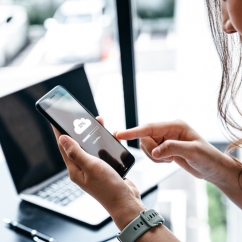Sales Strategy
How In-Store Marketing Is Evolving to Keep Retail Competitive March 10, 2025 (0 comments)

Atlanta, GA--Shopping habits are evolving, and physical stores must offer more than products to create engaging experiences. While online shopping grows, in-store marketing remains crucial for influencing purchasing decisions and building brand loyalty.
[Image via istockphoto.com]
According to an article on Mailchimp, retailers are leveraging personalized experiences, digital integration, and strategic store layouts to improve engagement and sales. Those who adapt to these trends can differentiate themselves and enhance customer loyalty.
Key Trends in In-Store Marketing
1. Personalized Shopping Experiences
Retailers are using AI and customer data to tailor recommendations and promotions. AI-powered kiosks and mobile apps suggest products based on past purchases, improving engagement and increasing repeat visits. Personalization strengthens the customer-brand relationship and boosts conversions.
2. Digital and Interactive Displays
Digital signage, QR codes, and AR tools make shopping more interactive. These technologies provide instant product information, highlight promotions, and allow customers to visualize items before purchasing. Mailchimp notes that digital integration enhances engagement and creates a seamless shopping journey.
3. Sustainability-Focused Marketing
Consumers increasingly favor brands with eco-friendly practices. Many retailers now incorporate sustainable store designs, minimal-waste displays, and educational signage about product sustainability. Highlighting these efforts builds trust and aligns with customer values.
4. Omnichannel Shopping Integration
Blending online and offline experiences ensures a consistent brand presence. Strategies like QR codes linking to exclusive online deals and in-store pickup for online orders help businesses bridge the gap between physical and digital shopping. According to Mailchimp, omnichannel experiences drive customer engagement and sales.
Effective In-Store Marketing Tactics
1. Strategic Store Layouts
Optimized layouts guide customers through the store and boost sales. Placing high-demand items at the back encourages browsing, while endcap displays drive impulse purchases. A well-planned layout improves the shopping experience and maximizes revenue.
2. Seasonal Promotions
Timely promotions attract shoppers and increase sales. Aligning marketing with key shopping seasons—such as holidays or back-to-school campaigns—ensures maximum impact. Pairing in-store displays with digital campaigns amplifies reach and engagement.
3. Employee Engagement
Well-trained staff enhance the in-store experience by providing product recommendations and personalized service. This direct interaction builds customer loyalty and increases conversions, making employees a crucial part of in-store marketing success.
4. In-Store Events
Hosting product demos, workshops, and exclusive events creates excitement and draws more customers. Live experiences encourage direct engagement with products, setting physical stores apart from online shopping. Mailchimp highlights that these events drive foot traffic and create memorable brand interactions.
Navigating Challenges in In-Store Marketing
Retailers face high costs, difficulty tracking ROI, and changing consumer behavior. Per Mailchimp, overcoming these obstacles requires:
- Clear Objectives: Define measurable goals for each campaign.
- Data-Driven Strategies: Use customer insights to tailor marketing efforts.
- Cost-Effective Solutions: Start with layout optimization before investing in advanced technology.
- Trend Awareness: Stay updated on industry shifts to maintain a competitive edge.
Learn more in this article by Mailchimp.






